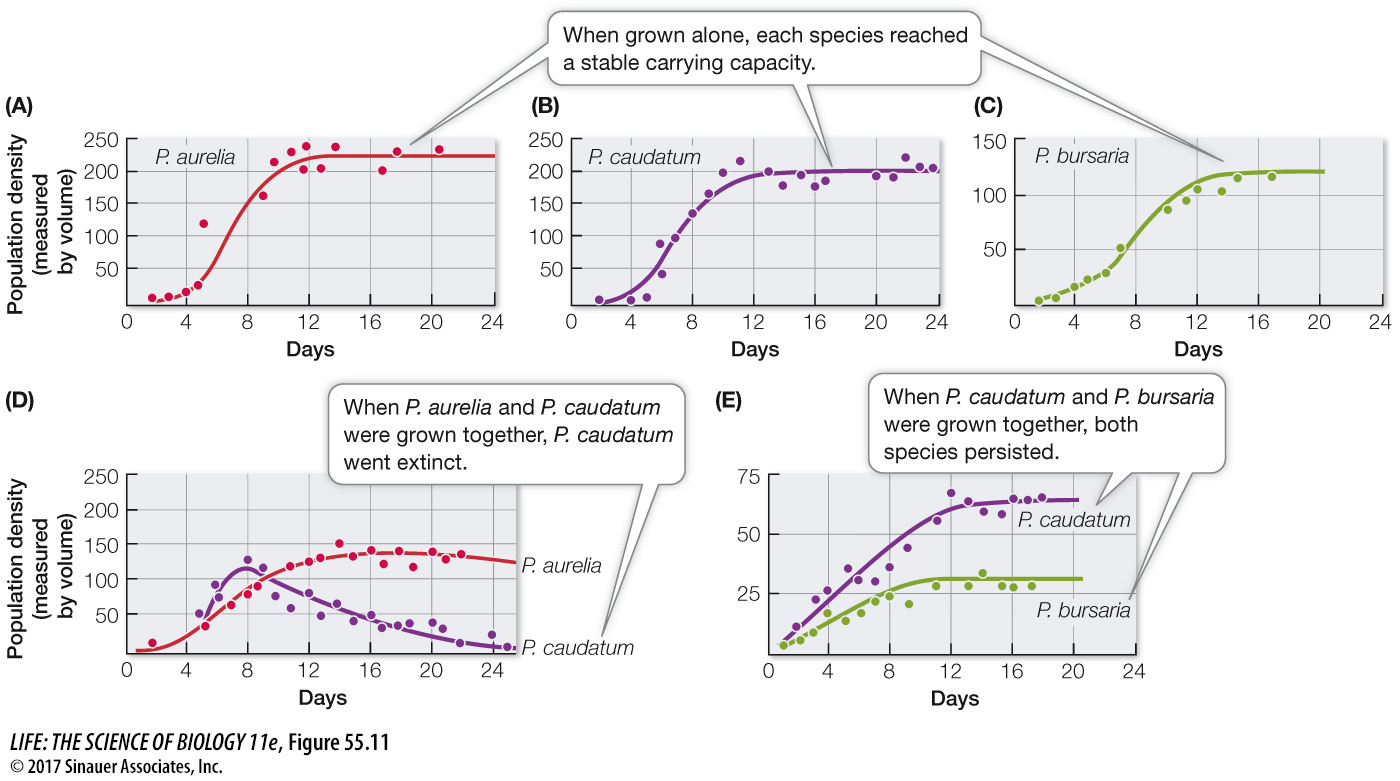Resource partitioning allows species to coexist despite overlapping use of limiting resources
Even though the potential for intense competition is high, various ecological and evolutionary mechanisms reduce competition. As you saw with the bee–shin dagger agave example, one way is through resource partitioning, or the sharing of limiting resources by using them in different ways. Another example of resource partitioning comes from the classic experiments performed by G. F. Gause in the 1930s using Paramecium, a single-celled protist. Gause grew three species of Paramecium in test tubes filled with growth medium that contained bacteria and yeast for food. When grown alone, each species showed *logistic population growth and reached a stable carrying capacity (Figure 55.11A–C). When pairs of species were grown together, however, they faced two possible outcomes: extinction or coexistence. Paramecium caudatum became extinct in the test tubes in the presence of P. aurelia but not when grown with P. bursaria (Figure 55.11 D and E). The difference in outcome, Gause suggested, was a consequence of P. caudatum and P. aurelia both competing for bacteria as a food source, while P. bursaria avoided competition by eating the other food source, yeast. Thus P. caudatum and P. bursaria partitioned their food resource in the presence of one another and were able to coexist as a result.
*connect the concepts Logistic population growth occurs when intraspecific competition causes population growth to slow down and eventually level off at some size known as the carrying capacity. Review Key Concept 54.2.

Figure 55.11 Competitive Exclusion or Coexistence? G. F. Gause grew three species of Paramecium in tubes filled with medium containing bacteria and yeast. (A–C) When grown alone, each species reached a stable carrying capacity. (D, E) When grown in pairs, P. caudatum faced two possible outcomes—extinction or coexistence—depending on whether P. aurelia or P. bursaria was present. P. caudatum and P. aurelia both fed mainly on floating bacteria, while P. bursaria fed mainly on yeast cells.
Question
Q: Predict what would happen if P. caudatum and P. bursaria both fed mainly on yeast cells.
If both P. caudatum and P. bursaria fed on yeast, one of the species would likely become extinct.
In some cases individuals within a species evolve different behaviors or morphologies depending on whether they are competing for resources with other species. Darwin remarked in On the Origin of Species that “Natural Selection leads to divergence of character; for more living beings can be supported on the same area the more they diverge in structure, habits, and constitutions.” This “divergence of character” is referred to today as character displacement. On some of the islands of the Galápagos archipelago, for example, certain cactus species are pollinated exclusively by the small ground-finch (Geospiza fuliginosa), for which cactus nectar is an important food source (see Figure 22.8). On other islands, a carpenter bee (Xylocopa darwinii) competes with the finches for cactus nectar; the birds consequently feed more often on seeds and insects. On the islands where bees are absent, the nectar-feeding birds have smaller wingspans, presumably to make it easier for them to negotiate the flowers.
Sometimes organisms respond to competition by moving. The African wild dog (Lycaon pictus) (see Figure 58.17) is a carnivore that lives and forages in packs (groups of related individuals). Frequent vocalizations, called twitters, function to keep the pack together, but these acoustical signals also can alert the dogs’ competitors, African lions (Panthera leo), to the presence of prey. Lions hearing the dogs’ twitters can use them to locate dog packs and steal their kills. The dogs avoid competing with lions by selecting areas for their dens where the likelihood of being overheard by lions is low. The wild dog is considered a fugitive species—a species that leaves an otherwise suitable habitat in order to avoid competition with another species.
